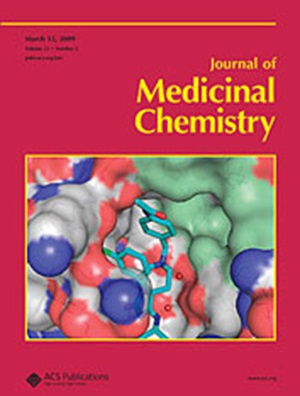Broad Target Screening Reveals Abundance of FKBP12-Based Molecular Glues in Focused Libraries
IF 6.8
1区 医学
Q1 CHEMISTRY, MEDICINAL
引用次数: 0
Abstract
Competitive (nondegradative) molecular glues represent a promising drug modality that remains underexplored primarily due to the lack of adequate hit identification approaches. In this study, we screened our historically grown FKBP-focused library containing >1000 drug-like molecules to identify FKBP-assisted molecular glues targeting a diverse panel of 57 proteins. In addition to establishing a robust and generalizable screening approach, we discovered three novel FKBP-dependent molecular glues targeting PTPRN, BRD4BD2, and STAT4. Our results demonstrate that molecular glues are more common than previously thought and that they can be identified by repurposing existing focused libraries. An optimized, highly cooperative FKBP12-BRD4BD2 glue demonstrated the involvement of the BD2 pocket and exhibited selectivity over the closely related BD1 domain. Our results underscore the value of FKBP12-assisted molecular glues to target challenging proteins with the potential for high selectivity.

广泛的靶标筛选揭示了fkbp12分子胶在重点文库中的丰度
竞争性(非降解)分子胶代表了一种有前途的药物模式,主要由于缺乏足够的命中识别方法而尚未得到充分开发。在这项研究中,我们筛选了包含1000个药物样分子的以fkbp为重点的文库,以鉴定针对57种不同蛋白质的fkbp辅助分子胶。除了建立一种强大的、可推广的筛选方法外,我们还发现了三种新的fkbp依赖性分子胶,靶向PTPRN、BRD4BD2和STAT4。我们的研究结果表明,分子胶比以前认为的更常见,并且可以通过重新利用现有的集中文库来识别它们。优化后的FKBP12-BRD4BD2胶具有高度的协同性,并对密切相关的BD1结构域具有选择性。我们的研究结果强调了fkbp12辅助分子胶在靶向具有高选择性的挑战性蛋白方面的价值。
本文章由计算机程序翻译,如有差异,请以英文原文为准。
求助全文
约1分钟内获得全文
求助全文
来源期刊

Journal of Medicinal Chemistry
医学-医药化学
CiteScore
4.00
自引率
11.00%
发文量
804
审稿时长
1.9 months
期刊介绍:
The Journal of Medicinal Chemistry is a prestigious biweekly peer-reviewed publication that focuses on the multifaceted field of medicinal chemistry. Since its inception in 1959 as the Journal of Medicinal and Pharmaceutical Chemistry, it has evolved to become a cornerstone in the dissemination of research findings related to the design, synthesis, and development of therapeutic agents.
The Journal of Medicinal Chemistry is recognized for its significant impact in the scientific community, as evidenced by its 2022 impact factor of 7.3. This metric reflects the journal's influence and the importance of its content in shaping the future of drug discovery and development. The journal serves as a vital resource for chemists, pharmacologists, and other researchers interested in the molecular mechanisms of drug action and the optimization of therapeutic compounds.
 求助内容:
求助内容: 应助结果提醒方式:
应助结果提醒方式:


